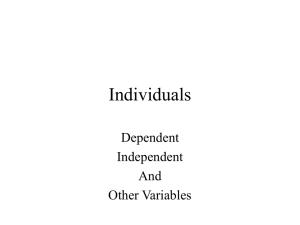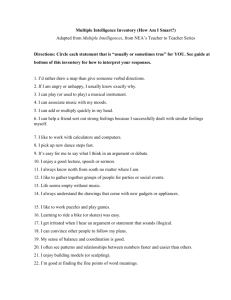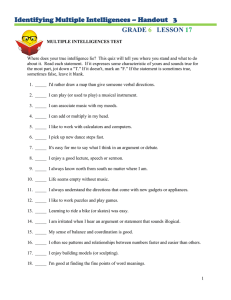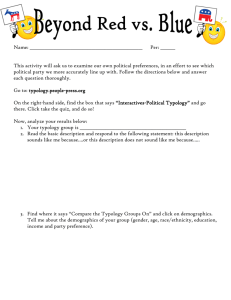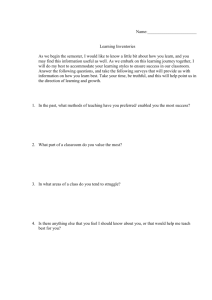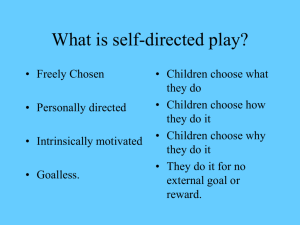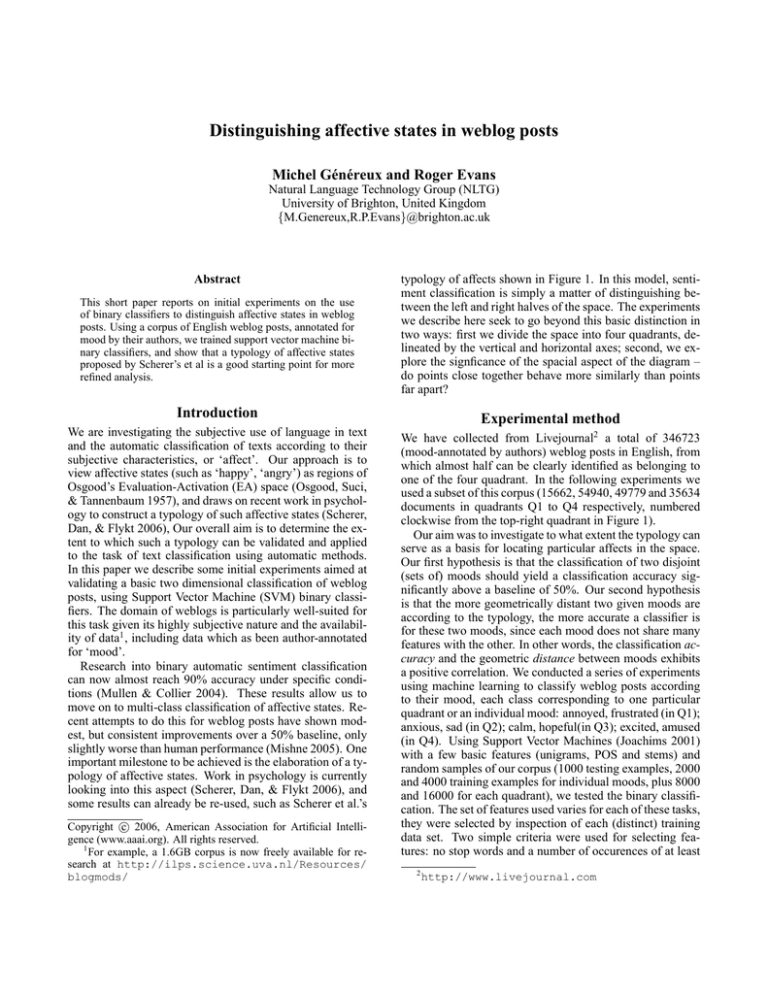
Distinguishing affective states in weblog posts
Michel Généreux and Roger Evans
Natural Language Technology Group (NLTG)
University of Brighton, United Kingdom
{M.Genereux,R.P.Evans}@brighton.ac.uk
Abstract
This short paper reports on initial experiments on the use
of binary classifiers to distinguish affective states in weblog
posts. Using a corpus of English weblog posts, annotated for
mood by their authors, we trained support vector machine binary classifiers, and show that a typology of affective states
proposed by Scherer’s et al is a good starting point for more
refined analysis.
typology of affects shown in Figure 1. In this model, sentiment classification is simply a matter of distinguishing between the left and right halves of the space. The experiments
we describe here seek to go beyond this basic distinction in
two ways: first we divide the space into four quadrants, delineated by the vertical and horizontal axes; second, we explore the signficance of the spacial aspect of the diagram –
do points close together behave more similarly than points
far apart?
Introduction
Experimental method
We are investigating the subjective use of language in text
and the automatic classification of texts according to their
subjective characteristics, or ‘affect’. Our approach is to
view affective states (such as ‘happy’, ‘angry’) as regions of
Osgood’s Evaluation-Activation (EA) space (Osgood, Suci,
& Tannenbaum 1957), and draws on recent work in psychology to construct a typology of such affective states (Scherer,
Dan, & Flykt 2006), Our overall aim is to determine the extent to which such a typology can be validated and applied
to the task of text classification using automatic methods.
In this paper we describe some initial experiments aimed at
validating a basic two dimensional classification of weblog
posts, using Support Vector Machine (SVM) binary classifiers. The domain of weblogs is particularly well-suited for
this task given its highly subjective nature and the availability of data1 , including data which as been author-annotated
for ‘mood’.
Research into binary automatic sentiment classification
can now almost reach 90% accuracy under specific conditions (Mullen & Collier 2004). These results allow us to
move on to multi-class classification of affective states. Recent attempts to do this for weblog posts have shown modest, but consistent improvements over a 50% baseline, only
slightly worse than human performance (Mishne 2005). One
important milestone to be achieved is the elaboration of a typology of affective states. Work in psychology is currently
looking into this aspect (Scherer, Dan, & Flykt 2006), and
some results can already be re-used, such as Scherer et al.’s
We have collected from Livejournal2 a total of 346723
(mood-annotated by authors) weblog posts in English, from
which almost half can be clearly identified as belonging to
one of the four quadrant. In the following experiments we
used a subset of this corpus (15662, 54940, 49779 and 35634
documents in quadrants Q1 to Q4 respectively, numbered
clockwise from the top-right quadrant in Figure 1).
Our aim was to investigate to what extent the typology can
serve as a basis for locating particular affects in the space.
Our first hypothesis is that the classification of two disjoint
(sets of) moods should yield a classification accuracy significantly above a baseline of 50%. Our second hypothesis
is that the more geometrically distant two given moods are
according to the typology, the more accurate a classifier is
for these two moods, since each mood does not share many
features with the other. In other words, the classification accuracy and the geometric distance between moods exhibits
a positive correlation. We conducted a series of experiments
using machine learning to classify weblog posts according
to their mood, each class corresponding to one particular
quadrant or an individual mood: annoyed, frustrated (in Q1);
anxious, sad (in Q2); calm, hopeful(in Q3); excited, amused
(in Q4). Using Support Vector Machines (Joachims 2001)
with a few basic features (unigrams, POS and stems) and
random samples of our corpus (1000 testing examples, 2000
and 4000 training examples for individual moods, plus 8000
and 16000 for each quadrant), we tested the binary classification. The set of features used varies for each of these tasks,
they were selected by inspection of each (distinct) training
data set. Two simple criteria were used for selecting features: no stop words and a number of occurences of at least
c 2006, American Association for Artificial IntelliCopyright °
gence (www.aaai.org). All rights reserved.
1
For example, a 1.6GB corpus is now freely available for research at http://ilps.science.uva.nl/Resources/
blogmods/
2
http://www.livejournal.com
Figure 1: Typology of affects from Scherer et al.
3 in the training data.
Results
Our first hypothesis is that, if the four quadrants proposed
by Scherer are a suitable arrangement for affective states in
the EA space, a classifier should perform significantly better than chance (50%). Table 1 shows the results for the
binary classification of the quadrants. By micro-averaging
accuracy, we obtain at least 60% accuracy for the four binary classifications of the quadrants. Our second hypotheBINARY CLASSIF.
Q1 vs Q2+Q3+Q4
Q2 vs Q1+Q3+Q4
Q3 vs Q1+Q2+Q4
Q4 vs Q1+Q2+Q3
Micro-accuracy
Random
Accuracy
67.40%
59.20%
56.50%
59.60%
60.68%
49.10%
Table 1: Distinguishing quadrants: Training 2000 and Testing 1000
sis predicts a correlation between accuracy and distance in
the EA space. Table 2 summarizes the results for all classification tasks carried out: the accuracy column represents
the average over all sets of training examples, in ascending
order, while the distance is a geometric measure of the distance between two moods (or the center of gravity for each
quadrant, assuming a uniform distribution of moods in the
random sample). The correlation column is the cumulated
Pearson correlation coefficient. For instance, from 57.93%
accuracy up to 65.35% accuracy, accuracy and distance displays a correlation coefficient of 0.423.
Analysis of results
Figure 1: how likely is it to classify 1000 weblogs and obtain at least 60% accuracy only by chance? A simple calculation using a binomial distribution (with X=600 successes,
n=1000 trials and probabilty(p) =0.5) yields to a probability
of 0.00000000013 . Therefore, it is safe to conclude that the
typology is very helpful in improving the performance of a
3
P(X>600,n=1000,p=0.5) = 1-P(X<=600) = 1-0.9999999999
= 0.0000000001
BIN. CL.
Q3 vs Q1+2+4
Act vs Pass
Q2 vs Q3
Ann vs Frustr
Anx vs Calm
Q3 vs Q4
Calm vs Hop
Q2 vs Q1+3+4
Exc vs Anx
Q4 vs Q1+2+3
Q2 vs Q4
Pos vs Neg
Anx vs Q4
Calm vs Exc
Q1 vs Q2
Ann vs Anx
Calm vs Q1
Exc vs Q2
Ann vs Calm
Ann vs Q3
Q1 vs Q3
Q1 vs Q2+3+4
Q4 vs Q1
Anx vs Sad
Exc vs Ann
Exc vs Amu
Acc.
57.93%
58.23%
58.65%
58.80%
59.10%
59.83%
61.10%
61.28%
62.75%
63.35%
64.35%
64.98%
65.30%
65.35%
66.53%
68.30%
69.20%
69.35%
70.05%
70.30%
70.58%
70.98%
72.43%
73.35%
75.00%
75.65%
Dist.
50
60
50
15
90
50
30
50
100
50
60
60
95
75
50
90
90
70
105
80
60
50
50
15
45
15
Corr.
1.000
-0.096
-0.666
0.204
0.086
-0.252
-0.192
0.334
0.230
0.228
0.227
0.387
0.423
0.332
0.434
0.504
0.489
0.568
0.574
0.521
0.441
0.360
0.162
0.095
-0.047
Table 2: Measuring correlation: Act = Active, Pass = Passive, Ann = Annoyed, Frustr = Frustrated, Anx = Anxious,
Hop = Hopeful, Exc = Excited
classifier into four distincts groups of affective states. These
results show that the abstraction offered by the four quadrants in the model seems correct. This is also supported by
the observation that the classifier shows no improvements
over the baseline if trained over a random selection of examples in the entire space.
Figure 2: interpreting the results with regards to our second hypothesis is more difficult. For most of the way while
moving upward along the accuracy dimension, the geometric distance between the two classes correlates positively.
However, the general trend turns out to be a slightly negative correlation. We believe there are mainly two factors that
can contribute to the distortion of the nature of the correlation between accuracy and distance:
non-uniform distribution of moods We have assume that
the random selection of moods within a quadrant was uniform, i.e. covering the whole of the space uniformely.
This is perhaps too optimistic, because moods that appear
more often in the corpus are likely to be over-represented
and therefore move the center of gravity of the quadrant
away from the center;
ambiguity of a mood location in the space There are two
moods represented in the experiments which appear at
more than one location in the typology: excited and sad.
We have attempted to minimize the impact of such ambi-
guity in the results by taking a location in the middle, but
this may have undesirabble side-effects.
The obvious solution to the first problem is to make sure
that we populate the training data with moods uniformly distributed in the space. If further research reveals that there are
further subcategory within a single mood, then a solution to
the second issue would be to create a distinctive tag for each
subcategory.
Future work
The next series of experiments should provide a more refined
validation of the typology and some insights into the use of
semantic orientation scores for the purpose of multi-mood
classification of texts.
Whilst we have validated the proposed partitioning of the
EA space for four regions as a whole, we now need to validate, for each quadrant, a more precise location for a number
of individual, uncontroversial moods. This can be achieved
by narrowing down the set of moods to those for which work
in psychology exhibits a certain level of certainty with regards to their location, while at the same time are in agreement with our second hypothesis.
The long term aim of this work is to classify texts according to their mood, making it possible to classify a text
according to more than two (positive vs negative or active
vs passive) classes (angry, sad, happy, etc.). To achieve that,
we will use directly the location of the affective states in the
space in combination with automatic continuous “scores” (in
the sense that they provide only a qualitative evaluation) of
the E and A axis. Scores such as PMI-IR (Turney & Littman
2003) provide a real value for each axis. They can be converted to “measures” (in the sense that they offer a basis for
comparison) between -1 and +1 by substituting the real PMIIR scores for every semantically oriented phrase in a text
with +1 or -1, and averaging over all phrases. By mapping
the E and A measures to normalized values in the EA space,
specific coordinates can be obtained and associated with surrounding affective states.
References
Joachims, T. 2001. Learning to Classify Text Using Support Vector Machines. Kluwer Academic Publishers.
Mishne, G. 2005. Experiments with mood classification
in blog posts. In Style2005 - the 1st Workshop on Stylistic
Analysis Of Text For Information Access, at SIGIR 2005.
Mullen, T., and Collier, N. 2004. Sentiment analysis using
support vector machines with diverse information sources.
In Empirical Methods in NLP.
Osgood, C. E.; Suci, G. J.; and Tannenbaum, P. H. 1957.
The Measurement of Meaning. University of Illinois.
Scherer, K.; Dan, E.; and Flykt, A. 2006. What determines
a feelings position in three-dimensional affect space? A
case for appraisal. Cognition and Emotion. (in press).
Turney, P. D., and Littman, M. L. 2003. Measuring praise
and criticism: Inference of semantic orientation from association. ACM Trans. Inf. Syst. 21(4):315–346.

